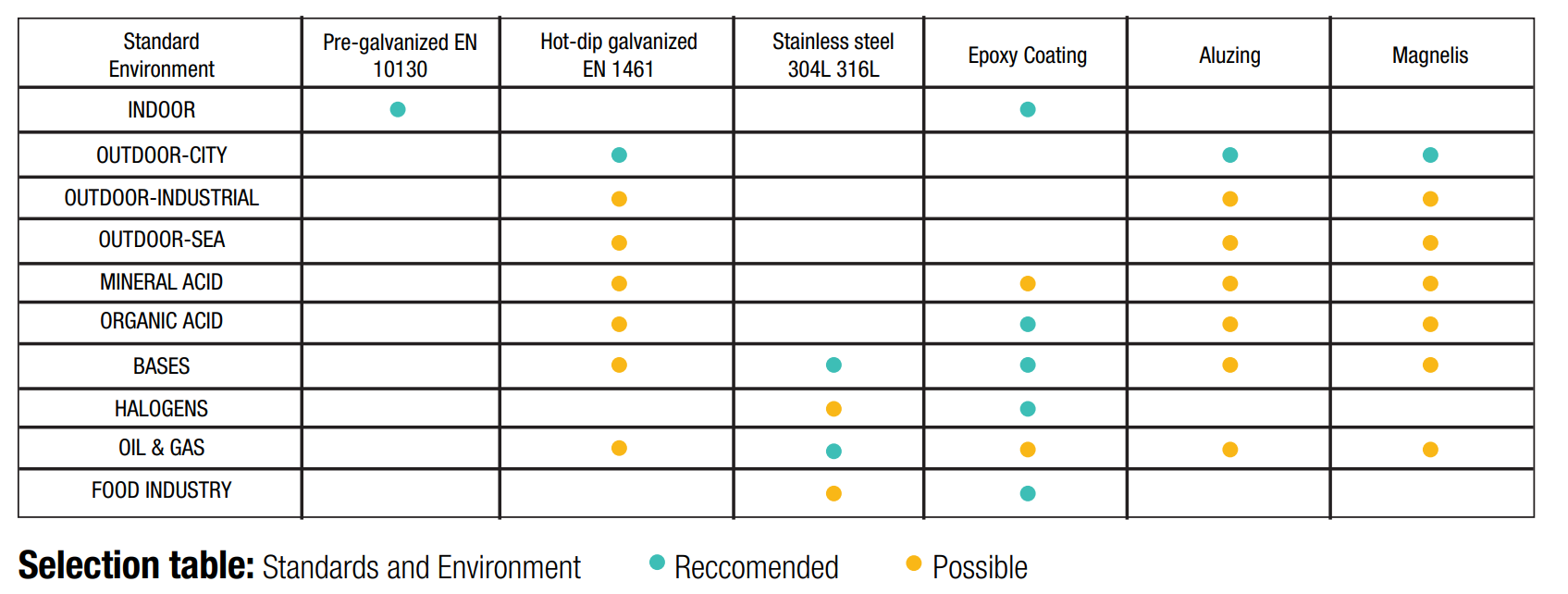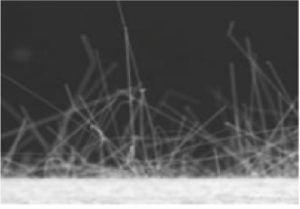MATERIALS AND FINISHES
Whether indoors or outdoors, in aggressive atmospheres or under special hygienic conditions: Kıraç Metal can
offer the perfect surface and materials for your cable management system, no matter what the requirements may
be. Kıraç Metal cable management systems are produced from high-quality sheet steel are available with various
surfaces
The selection of cable tray material and finishes depend on many factors as environmental conditions, corrosion
resistance, material handling and aesthetic view. Kıraç Metal cable trays are manufactured in mild steel, aluminium and stainless steel. Pre-galvanized, hot dip galvanized or powder coated with coloured coatings finished can
be provided.
All details relating to the materials and finishes of KıraçMetal cable trays are given below.

A) MATERIALS
The following materials are commonly used while manufacturing cable trays, cable ladders with all accessories:
Mild Steel – EN 10130 / EN 10025-2: Cold-rolled mild steel (EN 10130 / Grade DC01) and Hot-rolled mild steel
(EN 10025-2 / Grade S235JR) are used in various different applications requiring guaranteed forming, welding,
galvanizing and painting properties.
Pre-Galvanized Mild Steel – EN 10346: Pre-Galvanized steel is produced by coating coils of sheet steel with
zinc by continuously rolling the material through zinc at the mills. This steel refers to mill galvanized or hot dip mill
galvanized. The coating consists of zinc and the average coating weight can be either 100g/m2 (Grade
DX51D+Z100) or 275g/m2 (Grade DX51D+Z275) for all pre-galvanized steel.
Stainless Steel – EN 10088-2 : Particularly harsh environments mean that it is not the coating that needs to be
considered but the actual type of steel. Especially for tunnels, food and chemical industries stainless steel cable
tray products are being used. Kıraç Metal offers two main austenitic stainless steels, 1.4301 (AISI 304) and
1.4401 (AISI 316), for their high resistance to corrosion, obtained partly due to their high chromium content
All welded stainless-steel products undergo a pickling, glass bead blasting or passivation treatment. These two
steps are fundamental to the product’s life and the installation’s longevity. Unwelded components are rinsed and
degreased. Pickling and our special passivation give stainless steel a light grey matte appearance. To protect
stainless steel products against scratches one solution is to wrap products in film / PVC received from manufacturer until delivery
Aluminium – AA 6063: Cable trays fabricated of aluminium are often used for their high strength-to-weight ratio,
superior resistance to certain corrosive environments and ease of installation. They also offer the advantages of
being light in weight approximately less than 40% that of a steel tray and maintenance free, and since aluminium
cable trays are non-magnetic, electrical losses are reduced to a minimum. Our aluminium cable tray products are
formed from the AA 6063 series alloys, which by design are copper-free alloys for marine applications.
B) FINISHES
GALVANIZATION:
Galvanization is the process of applying a protective zinc coating to metal, in order to prevent rusting and
galvanic corrosion. The most common method in current use is hot-dip galvanization, in which steel parts are
submerged in a bath of molten zinc.
Firstly, zinc coatings prevent corrosion of the protected metal by forming a physical barrier, and secondly by
acting as anode if this barrier is damaged. When metal is cut and exposed to atmosphere, zinc reacts with
oxygen to form zinc oxide, which further reacts with water molecules in the air to form zinc hydroxide. Finally
zinc hydroxide reacts with carbon dioxide in the atmosphere to yield a thin, leakproof, grey layer of zinc
carbonate which connects extremely well to the underlying zinc, so protecting it from further corrosion.
Kıraç Metal offers cable management systems with several galvanization options;
Hot-Dip Galvanization Finish – EN 1461: It is a coating method that requires dipping steel manufactured
products in molten zinc bath after production according to EN 1461 standards. A chemical bond with steel can
be established by this method and provides overall protection with coating inside, outside, corners and small
points of the material. It is not recommended to cut, drill or do any later operations on hot dip galvanized products. If it is necessary to do, after this operation, galvanized spray should be applied to protect the surface.
Hot-dip galvanization finishes are preferred for outdoor use. For cable management systems average coating
thickness applied is 45- 55 μm.
Alkali Zinc + Lac Finish – EN 2081: Fasteners used standard for Kıraç Metal cable management systems
have alkali zinc+lac finish.
Zinc Whiskers Problem:
For a data center, zinc whiskers might eventually have an impact on operations causing short circuits or
resulting in equipment malfunction or failure. Zinc-whisker-related problems can be difficult to diagnose
because the particles disintegrate when a short circuit occurs

The zinc whisker phenomenon has been directly attributed
to the electrogalvanizing process. While hot-dip galvanization still involves coating steel in zinc, it creates a more
durable zinc layer than electrogalvanizing. The best way to
counteract zinc whiskers is to minimize use of electrogalvanized materials. Offering products that are either hot-dip
galvanized, powder-coated or stainless steel would be the
best starting point.
Pre-Galvanization Finish – EN 10130: Pre-galvanized steel comprises of sheet metal which has been hot dip galvanized in continuous production lines. Pre-galvanized finishes are mostly used indoors. Average coating
thickness is 14 μm for 100gr/m2 coating and 38 μm for 275 gr/m2 coating.
Aluzinc Finish – EN 10327: Aluzinc is cold rolled steel with metal coating composed of Aluminium, Zinc and
Silicium. Aluzinc, Zincalume and Galvalume are different trade names of this product. Aluzinc coatings have 3 to
7 times lower corrosion rate than hot dip galvanized coatings; corrosion rates vary according to the severity of
conditions
The protective mechanism for aluzinc and hot-dip galvanized steel are such that the hot-dip galvanized coating
initially protects better, but the zinc coat will gradually corrode away more and more in the vicinity of the edge
and the protective effect will be lost. Then the aluminium part of the aluzinc coating will persist for a longer
period, and the protection will thereby remain. The primary purpose for addition silicium is to minimize the
growth of the brittle intermetallic layer that forms when steel is zinc-coated using the hot-dip process.
Magnelis Finish – EN 10327: Magnelis is a highly durable metallic steel coating providing surface protection in
a variety of applications against long-term wear and tear. It is a mild steel product coated on both sides with a
zinc-aluminium-magnesium alloy. Magnelis coatings have up to 10 times lower corrosion rate than hot dip
galvanized coatings; corrosion rates vary according to the severity of conditions. An innovative metallic coating
that offers protection in the harshest environments, magnelis protects exposed cut edges with a thin zinc-based
protective film with magnesium, which prevents corrosive reactions.
EPOXY POWDER COATING:
The powder coating makes the cable trays superiorly permanent and resistant to corrosion. After coating cable
tray are absolutely secured from rust and other rough corrosive factors, which leave the products with the best
of finishes. The most effective type of coating is epoxy powder coating.
The process of epoxy powder coating involves spraying the dry, electrostatically charged powder paint onto the
electrically grounded objects. The powder particles are attracted to the metal and stick uniformly to every
exposed part of the object. The powder is cured by baking it onto the object, forming a skin over the surface of
the metal. The coating provides a high corrosion protection, save maintenance time, with excellent adhesion.
Epoxy powder coating is available in a variety of colours according to classical RAL system of colours.
The epoxy powder coating is applied to mild steel, with average thickness of 70-80 microns.

